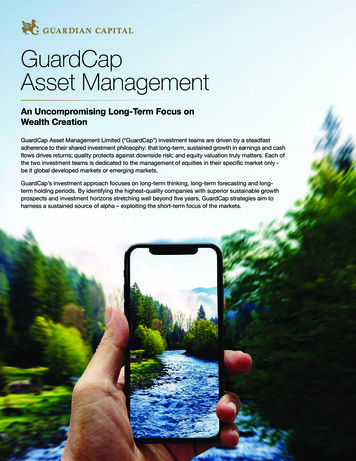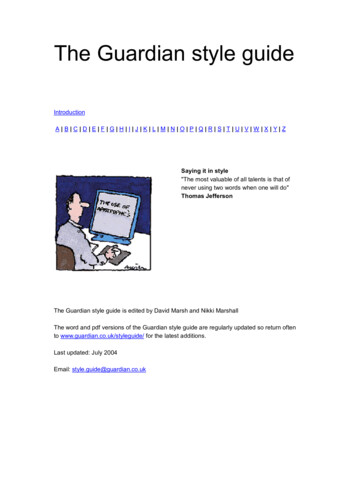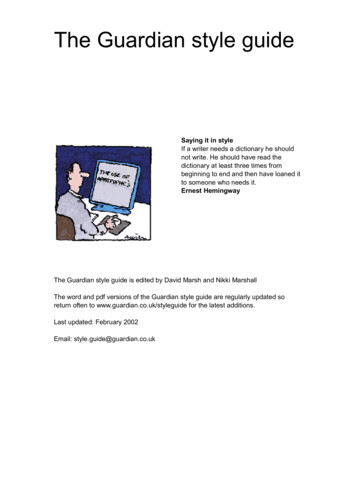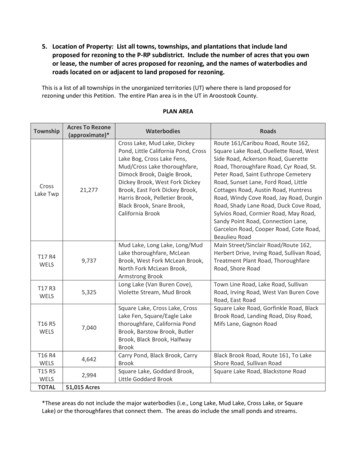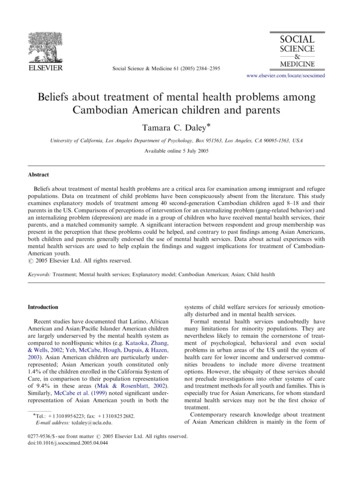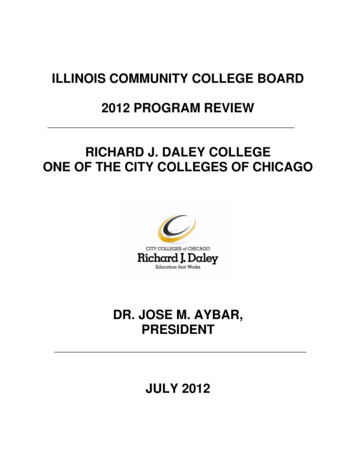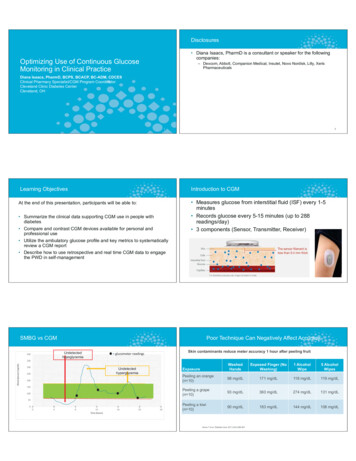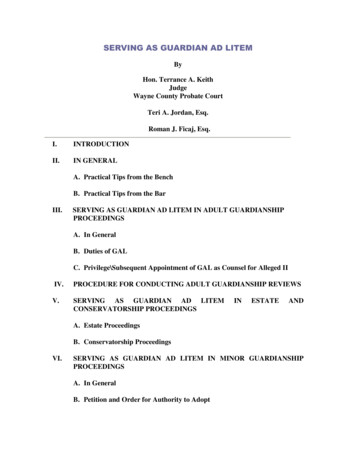
Transcription
A triumph that the world deserves to see.Paul Daley, The GuardianAN INTERNATIONAL TOURING EXHIBITION PRODUCED BY THE NATIONAL MUSEUM OF AUSTRALIA
AcknowledgementsArt centresAnangu PitjantjatjaraYankunytjatjara (APY)elders and supportersErnabella ArtsNgaanyatjarra eldersand supportersMinyma Kutjara Arts ProjectMartu elders and supportersPapulankutja ArtistsAlive with the Dreaming!Songlines of theWestern Desert partnersAustralian Research CouncilAustralian National UniversityMartumili ArtistsMaruku ArtsNinuku ArtsSpinifex Arts ProjectTjanpi Desert WeaversTjungu Palya ArtistsWarakurna ArtistsWarburton Arts ProjectAnanguku ArtsDomeLabAustralian HeritageManagement SolutionsTravelling Kungkarangkalpa isa digital immersive experiencestaged in DomeLab, a collaborationbetween the University of NewSouth Wales and the NationalMuseum of Australia, togetherwith nine other tertiary and culturalorganisations. It is funded as part ofan Australian Research Council LIEFgrant (2015) led by chief investigatorProfessor Sarah Kenderdine.Ngaanyatjarra PitjantjatjaraYankunytjatjara Women’s CouncilNational Museum of AustraliaThe Australian Governmentand the Department of thePrime Minister and CabinetUniversity of New England(collaborating organisation)(cover) montage photographs by Sarah Kenderdine, Peter Morse and Paul Bourke;Seven Sisters rock art with permission of Walinynga (Cave Hill) traditional owners.(this page) Mary Katatjuku Pan dances solo at the Seven Sisters inma workshop atBalfour’s Well, 2012. Photo: Wayne Quilliam, ‘Songlines of the Western Desert’ ARC project.(back cover) Walinynga (Cave Hill) rock art. Photo: June Ross, University of New England
[Seven Sisters] is not just one songline — they travelled all aroundAustralia. And even other people overseas know the SevenSisters story in their own way, so it’s a special story. It’s not onlyhappening here in Australia but it happened everywhere else.Ngalangka Nola Taylor with Kumpaya Girgirba, 2017AN INTERNATIONAL TOURING EXHIBITION PRODUCED BY THE NATIONAL MUSEUM OF AUSTRALIA
An ancient creation saga featuring a dramatic chase across theAustralian deserts is at the heart of this groundbreaking exhibition.Songlines: Tracking the Seven Sisters is compelling inscale and complexity, conveying an Indigenous founding narrativeby using Indigenous ways of passing on knowledge. It is rich withAboriginal voices and tangible expressions of the songlines —featuring more than 100 paintings, sculptures and ceramics,as well as state-of-the-art multimedia.The artworks in this drama are portals to the deserts of the Martu,the Ngaanyatjarra and the Anangu Pitjantjatjara Yankunytjatjarapeoples, through which visitors step to journey in thefootsteps of the Seven Sisters.2
This is not an art exhibition, a history exhibition or a scienceexhibition. It is all of these. It is both an Australian Aboriginalexhibition and a universal story of mankind. It offers us connectivityto each other and our planet in a fragmenting world. It is profound!Margo Neale, Senior Indigenous CuratorKungkarangkalpa — Seven Sisters, 2015, by Tjungkara Ken, Yaritji Young, Maringka Tunkin, Freda Brady andSandra Ken, Tjala Arts, acrylic on canvas, National Museum of Australia, the artists / Copyright Agency, 2018NATIONAL MUSEUM OF AUSTRALIA3
What are songlines?Like the epic poems of the great oral traditionsof the world, songlines are a way of holding andpassing on knowledge. They contain protocolsof behaviour and information for survival inan unpredictable and volatile environment —where food and water can be found, how tomanage these scarce resources, where thereis potential risk, and how to minimise that risk.By embedding this knowledge in a story,and performing it in dance and song, anentire continent has been mapped by andfor its people.Songlines, or Dreaming tracks, map theroutes and activities of Ancestral beings asthey travelled across Australia. Custodianshipof the stories, involving rights, responsibilities,gender, kinship and relationship to country,are layered into the cultural aspects of theexperience. It is a knowledge system that is asancient as the land itself.DarwinRoebourneMartu countryAlice SpringsUluruNgaanyatjarra LandsBrisbaneAPY LandsPerthAdelaideSydneyCanberraMelbourneHobart4
Seven Sisters, 2016, by Yaritji Young, Tjala Arts, acrylic on linen, National Museum of Australia, the artist / Copyright Agency, 2018The songlines of the women of central Australia arealso the heritage of non-Aboriginal Australians.It is this culture that is the Iliad and Odyssey of Australia.It is these mythic stories that are Australia’s Book of Genesis.Noel Pearson, A Rightful Place, 2014NATIONAL MUSEUM OF AUSTRALIA5
The exhibitionSonglines: Tracking the Seven Sisters is highlyimmersive and experiential, where visitorsjourney along the Ancestral routes of thesisters as they flee across deserts, pursuedrelentlessly by a lusty sorcerer known as Nyiruor Yurla. This is an epic tale of tragedy andcomedy, obsession and trickery, desire andloss, solidarity and sorrow — a universal dramaplayed out in the night sky by Orion and thePleiades, and a terrestrial creation story inwhich the land has a starring role.The exhibition aims to preserve the SevenSisters story for its future custodians, and forthe enrichment of Australia and the world.A Jukurrpa [Dreaming] is one particular line, one pathway.When you follow that journey you’ll see where they [the sisters]left behind parts of their stories. You gotta follow their footprints.You can see parts of the story in the land.Ngalangka Nola Taylor with Kumpaya Girgirba, 2017‘Virtual elder’ Alison Milyika Carroll, with Tjitji Kutjara,2011, by Alison Munti Riley, Tjala Arts (left), andSeven Sisters, 2016, by Yaritji Young, Tjala Arts (right).Photo: George Serras, National Museum of Australia.All artworks the artists / Copyright Agency, 20186
The objectsIn retelling the Seven Sisters story, the Centraland Western deserts are mapped acrossthe exhibition gallery and populated with astunning collection of artworks, many createdespecially for the exhibition.(above) Kungkarangkalpa (Seven Sisters) ceramics: Ili (NativeFig) by Fiona Wells, Wayanu (Quandong) by Tjimpuna Williams,Inma Walka (Ceremonial Designs) by Alison Milyika Carroll,Ernabella Arts, glazed stoneware with underglaze, NationalMuseum of Australia. (below) Snake sculptures and kurlata(spears) by artists from Maruku Arts displayed in the WatiNyiru Room. Photo: George Serras, National Museum ofAustralia. All artworks the artists / Copyright Agency, 2018NATIONAL MUSEUM OF AUSTRALIA7
Just like the old people, we are dreaming.We have a new dream with technology.We’re using the newest technology with the oldest culture.Curtis Taylor, 2010(background) Satellite image of Martu country, 2017. GoogleEarth – Image 2017 DigitalGlobe and Image 2017 CNES/Airbus. (inset) The Dome in the Songlines exhibition space.Photo: George Serras, National Museum of Australia8
The DomeThe multimedia DomeLab experience is shownin the world’s first high-resolution travellingdome. It transports visitors to Walinynga(Cave Hill), the only known rock art site depictingthe Seven Sisters story.Accompanied by the voice of traditionalowner Stanley Douglas, visitors will standbeneath the remarkable images capturedusing high-definition cameras and transformedinto a cinematic and immersive storytellingexperience, Travelling Kungkarangkalpa.Also featured in the Dome are animatedartworks, such as the three dimensional tjanpi(grass) figures of the Seven Sisters which soarthrough the skies, and the transit of Orionand Pleiades.Viewing Travelling Kungkarangkalpa, 2017, in the Dome.Photo: Sarah Kenderdine, UNSW. Artwork the artists /Copyright Agency, 2018NATIONAL MUSEUM OF AUSTRALIA9
LYNETTE WALLWORTH INSTALLATIONLynette Wallworth is an Emmy Award-winningfilmmaker and artist who uses immersiveenvironments and interactive narratives toexplore the connections between people and thenatural world. Her installation, Always WalkingCountry: Parnngurr Yarrkalpa, recreates thedesert in which the majestic Yarrkalpa (HuntingGround) painting — a highlight of the exhibition— was created.This encyclopaedic painting contains anuanced knowledge of plants and animals,of seasons and fire, of permanent water andephemeral soaks. It is also a topographic replicaof the landscape around Parnngurr in WesternAustralia: ranges and sand-hills, creeks and rockholes. The Minyipuru (Seven Sisters) flit acrossthe western side of the painting, pursued by themischievous Yurla. Their presence in the paintingis incidental, just one strand in the fabric of Martudaily life.For several days in searingly hot conditions,Wallworth and her crew filmed eight seniorMartumili artists as they sang and painted theirstory into life creating a striking 5 x 3 metremasterpiece in order to pass their knowledge ofcountry onto young Indigenous rangers.VIRTUAL ELDERSVisitors are welcomed to the exhibition byseveral virtual elders on life-sized digital screens.They also appear throughout the exhibition,filling the space with Indigenous voices as theyshare their stories.(top) Visitors immersed in Always Walking Country: ParnngurrYarrkalpa, an installation by Lynette Wallworth. (opposite)Yarrkalpa (Hunting Ground), 2013, by Kumpaya Girgirba,Yikartu Bumba, Kanu Nancy Taylor, Ngamaru Bidu, YuwaliJanice Nixon, Reena Rogers, Thelma Judson and NgalangkaNola Taylor, Martumili Artists, National Museum of Australia.Photo: George Serras, National Museum of Australia10
I see the painting as a skin lifted from the land and restingon the floor, holding the sinews of the country underneath it.Lynette Wallworth, 2017NATIONAL MUSEUM OF AUSTRALIA11
Kuru Ala (meaning ‘eyes open’), a striking rock formationwith two caves that look like eyes under a jutting brow.Photo: Annieka Skinner, Tjanpi Desert WeaversAdditional resourcesSonglines: Tracking the Seven Sisters websiteTo support the exhibition, the National Museum of Australia has developed extensive onlineresources that document the artworks and the artists featured in the inesCatalogueA significant catalogue printed in both hardcover and paperback accompanies the exhibition.Through artworks, stories and in-depth analyses, the book provides an important resource forthose interested in knowing more about these complex pathways of spiritual, ecological, economic,cultural and ontological knowledge — the stories ‘written in the land’.The National Museum of Australia welcomes approaches from institutions or publishersinterested in producing an adapted or translated s/shopArt centre hubThe National Museum of Australia worked closely with Indigenous artists to develop a range ofmerchandise, including paper products, textiles, jewellery, accessories and other mementos.While on display at the Museum, Songlines: Tracking the Seven Sisters featured an art centrehub, a recreation of the Aboriginal-owned art centres that are dotted across the Central and Westerndeserts of Australia. These hubs are where people learn to run businesses and become leaders ina cross-cultural world. People engage in a range of artistic practices, from painting, carving andweaving to the newest media technologies.In the exhibition’s art centre, visitors could watch artists at work and buy their creations such asweavings, baskets and paintings. Through the sale of original art and the Songlines product line, theparticipating art centres have seen significant returns with cost-sharing arrangements in place tosupport the communities.The Museum will provide advice on merchandising opportunities and will be able to sourceproducts from approved suppliers in Australia.12
Minyipuru at Pangkal, 2016, by Mulyatingki Marney, Nancy Nyanjilpayi Chapman and May Wokka Chapman,Martumili Artists, acrylic on canvas, National Museum of Australia. Photo: George Serras, National Museum of AustraliaThe Seven Sisters Tjukurpa, our Dreaming creationlaw, is very important to us, we hold it stronglyand teach to the generations who come after us.This Tjukurpa travels through many people’s country.Inawinytji Williamson, 2017NATIONAL MUSEUM OF AUSTRALIA13
The tracks of the Seven Sisters at Walinynga (Cave Hill).Photo: June Ross, University of New EnglandSummary of specificationsExhibition sizeThe size of the exhibition will vary fromapproximately 600–800m2, dependent on theinclusion of the Dome. Note that the Dome canbe installed outside of the main gallery.Multimedia DomeThe Dome requires a minimum clear floor areaof 10m2, with a surrounding clearance of 6.5m.It also requires three-phase five-pin poweroutlets and a local high speed internetconnection with remote access.DesignThe exhibition layout follows the Seven Sistersstory geographically, ancestrally and spiritually.Works are arranged according to their place oforigin (sites) as well as by their place in the SevenSisters narrative, enabling visitors to ‘walk’along the songlines. The National Museum ofAustralia will provide advice and feedback onthe proposed layout for your venue.Object cratesObjects will be crated for transport. Crates mustbe stored in dry, pest-free conditions by thevenue for the duration of the display.14FreightThe National Museum will coordinate allarrangements for freight. Exhibition objectcrates are to be transported by airfreight. Forground transport the exhibition object cratesare to be transported in a climate-controlled,air-ride, rigid pantec vehicle.Environmental conditionsThe venue must have temperature- andhumidity-controlled gallery spaces that allowfor 20 degrees /– 3 degrees Celsius and50% relative humidity (RH) /– 5% constantconditions.The exhibition space should have controlledexhibition lighting, preferably with no naturallight as the Dome requires complete darknessto operate at peak resolution.SecurityThe venue will need to provide electronic andphysical security within the gallery space.Install and takedownThe National Museum will provide assistance tothe venue to install and de-install the exhibition.
Walinynga (Cave Hill) rock art: the concentric circlesrepresent the Seven Sisters, and the yellow dots their food.Photo: June Ross, University of New EnglandExhibition supportMarketingThe National Museum of Australia will provideadvice on marketing and will need to approveany artwork for printed products such assignage, brochures and advertising material.Artwork for use in print advertising and/orprinted posters will be provided along with astyle guide. A media release and a selection ofcopyright-cleared images will be provided to thevenue for marketing and media purposes.Associated programming and opening eventThe National Museum will assist in coordinatingan opening event and a range of public programsat the host venue and will provide advice andapproval on matters of Aboriginal culturalprotocols. Key artists from the exhibition maybe able to attend the opening and contributecultural performances, offering a range of richand engaging public programs.The Museum will collaborate with the touringvenue to develop an appropriate program andcoordinate artist travel, public lectures andperformances to promote the exhibition.CopyrightThe National Museum will coordinate all aspectsof communication with Aboriginal artists andrelevant Aboriginal organisations, includingcopyright clearance.CostsFees available upon request.Sponsorship opportunityThe National Museum of Australia is seeking acorporate partner to support the internationaltour of the Songlines: Tracking the Seven Sistersexhibition. Please contact Annalisa Millar,Head of Development, for further information:annalisa.millar@nma.gov.au or 02 6208 5040EXHIBITION CONTACTSMs Sarah OzolinsInternational Programs ManagerNational Museum of AustraliaGPO Box 1901, Canberra ACT 2601, AUSTRALIAPhone: 61 2 6208 5203E-mail: sarah.ozolins@nma.gov.auNATIONAL MUSEUM OF AUSTRALIA15
Kuru Ala, 2016, by Estelle Inyika Hogan, Myrtle Pennington, Ngalpingka Simms, Lorraine Davies, Debbie Hansen andTjaruwa Angelina Woods, Spinifex Arts Project, acrylic on linen, on loan from Wayne and Vicki McGeoch Collection, the artists / Copyright Agency, 201816
The National Museum of Australia is the place whereAustralian stories come alive. Located in Canberra, thecapital city of Australia, the Museum explores the richand diverse stories of Australia’s land, nation and people.Photo: Adam McGrath, Hcreations
This is Australia’s oldest story. A sweeping tale that uncoversthe deep truths of our landscape — ancient stories riven intothe very rocks and soil. It divulges powerful lessons aboutwhat it means to be human and to live in this country.Dr Mathew Trinca, Director, National Museum of Australia
Janice Nixon, Reena Rogers, Thelma Judson and Ngalangka Nola Taylor, Martumili Artists, National Museum of Australia. Photo: George Serras, National Museum of Australia 10. . hub, a recreation of the Aboriginal-owned art centres that are dotted across the Central and Western deserts of Australia. These hubs are where people learn to run .


